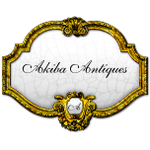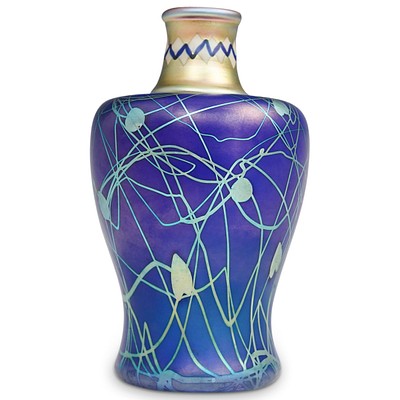Steuben Crystal Pheasant
Lot 424
About Seller
Akiba Antiques
3 N Federal Hwy
Dania Beach, FL 33004
United States
Akiba Antiques, founded by Charles and Franceska Akiba in the 1980’s in Paris, France started by buying and selling fine arts. Franceska specialized in French furniture from the fine Napoleonic Era to La Belle Epoque, to Art Nouveau and Art Deco; While Charles’ expertise lied in European paintings b...Read more
Categories
Estimate:
$100 - $1,000
Absentee vs Live bid
Two ways to bid:
- Leave a max absentee bid and the platform will bid on your behalf up to your maximum bid during the live auction.
- Bid live during the auction and your bids will be submitted real-time to the auctioneer.
Bid Increments
| Price | Bid Increment |
|---|---|
| $0 | $20 |
| $500 | $50 |
| $1,000 | $100 |
| $2,000 | $250 |
| $5,000 | $500 |
| $10,000 | $1,000 |
| $25,000 | $2,500 |
| $50,000 | $5,000 |
| $100,000 | $10,000 |
| $250,000 | $25,000 |
About Auction
By Akiba Antiques
Jul 29, 2021
Set Reminder
2021-07-29 12:00:00
2021-07-29 12:00:00
America/New_York
Bidsquare
Bidsquare : The Marvelous Collection of Mr & Mrs Shovers
https://www.bidsquare.com/auctions/akiba-antiques/the-marvelous-collection-of-mr-mrs-shovers-7184
The collection of Alan and Susan Shovers offers one of the rarest selections of Steuben glass available. Alan and Susan are both experts in the field - together, they authored the book "Objects of Desire: The Art of Frederick Carder" Akiba Antiques info@akibaantiques.com
The collection of Alan and Susan Shovers offers one of the rarest selections of Steuben glass available. Alan and Susan are both experts in the field - together, they authored the book "Objects of Desire: The Art of Frederick Carder" Akiba Antiques info@akibaantiques.com
- Lot Description
DESCRIPTION: Steuben crystal pheasant sculpture.
Pressed and cut Lead Glass
Cast as a solid block in the shape of a sitting pheasant with a flat base and no visible feet. Head, breast, wings and long tail are wheel-cut and polished with grooves simulating feathers.
Rockwell Gallery, N.Y. label attached.
Reference:
Fig. 6504, p.236 Paul V. Gardner.
Shown in the 1932 catalog at p. 11 for $35.
Shown p. 164 of Objects of Desire: The Art of Frederick Carder by Alan Shovers.
Shown at p. 281 of Steuben Glass An American Tradition in Crystal by Mary Jane Madigan. Shown as a stock piece. Shown as 1932 with design credit to Bolas Manikowski and Frederick Carder.
Shown in The Collectors Encyclopedia of American Art Glass by Shuman, page 170.
In the Steuben line in 1934. Dimitroff p.75. Pheasant was popular and examples are numerous. “For a designer who was said to have disliked cut glass, Carder certainly produced a lot of it. His cut designs of the post-1918 period, in contrast to the 1903-15 group, are bold and unconventional. They are nothing like the designs created by his American competitors.” P. 163 Dimitroff. In faceted pieces Carder used cutting to shape the outline of the glass.
See Fig. 2.40, p. 24 of Dimitroff where it is stated: “Relatively few brilliant cut items were designed by Carder at Steuben.” Further, at p. 256 the author states: “Carder’s deep, brilliant cut pieces are just plain rare in any shape or in any color.”
In Frederick Carder: Portrait of a Glassmaker by Paul V. Gardner at p.28 the author states: His skilled cutters produced about 200 decorative patterns on elaborate console sets, stately covered jars, monumental centerpieces, and a few table services. Among the rarest cut pieces are an ornamental peacock, pheasant, eagle, and Pegasus, a fanciful concept of the fabled winged horse.
“Steuben made many articles in pressed glass--ashtrays; Lincoln and Washington Head plaques with metal bases; eagle, pheasant, gazelle, duck, and pigeon figurines (later cut and polished to remove the mold marks);” p. 178, American Art Nouveau Glass by Albert Christian Revi.
Seen at p. 41 of article Carder Steuben Glass by Robert Mueller, in Glass Collectors Digest, Volume XIV, Number 6, April/May 2001. At p. 43, Some of Carder’s most impressive cut engraved work appears on figural animals, such as the pheasant, eagle, and pigeon. These table display sculptures were mold pressed, then hand cut to add details to the design.
Shown in 1926 House and Garden ad by Steuben Glass Blown and molded(id) at Steuben Furnaces, Corning, N.Y. AD labeled Precious pieces of Modern Glass hand wrought in the old tradition. Inscription reads The crystal birds are a triumph of glass making art.
In Steuben Seventy Years of American glassmaking by Perrot, Gardner and Platt, the authors say p. 55: In addition to the pigeon, cut crystal eagle, pheasant, duck and peacock table ornaments were made. These objects were among the few Carder Steuben pieces in which the basic shape was formed in a mold and the feathers and other details added by the glass cutters after the piece was annealed.
In The Complete Cut and Engraved Glass of Corning by Estelle F. Sinclaire and Jane Shadel Spillman, the author’s state at p. 198: Such art objects as the Carder-Steuben birds illustrate another characteristic Carder use of cutting: as texture or background. In the Steuben eagle, cutting reminiscent of the hollow or St. Louis diamonds suggests the texture of feathers.
A pair pictured at p. 153, of Encyclopedia of American Cut and Engraved Glass by Albert Christian Revi. At p. 150 author says, “Beautifully cut crystal pheasants were made in pairs as mantel ornaments.”
Provenance:
Estate of Mr. and Ms. Alan Shovers
Purchased from Rockwell Gallery of Corning, N.Y. on 7/26/00.
CIRCA: Early 1900s
DIMENSIONS: H: 6.75" x D: 11.5"
CONDITION: Great condition. Normal signs of age. See lot description for details on item condition. More detailed condition requests can be obtained via email (info@akibaantiques.com) or SMS 305-332-9274. Any condition statement given, as a courtesy to a client, is only an opinion and should not be treated as a statement of fact. Akiba Antiques shall have no responsibility for any error or omission. - Shipping Info
-
For shipping please contact our 3rd party shipper: UPS STORE 954 4541131 auctions1937@gmail.com Contact Name:David
-
- Payment & Auction Policies
-
Available payment options
Thank you and congratulations on your new purchase!
-
-
- Buyer's Premium



 EUR
EUR CAD
CAD AUD
AUD GBP
GBP MXN
MXN HKD
HKD CNY
CNY MYR
MYR SEK
SEK SGD
SGD CHF
CHF THB
THB























